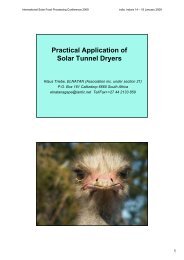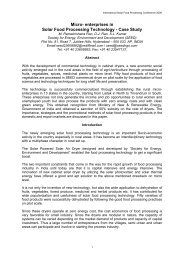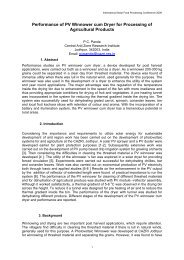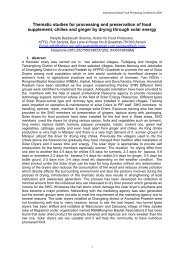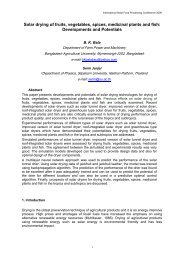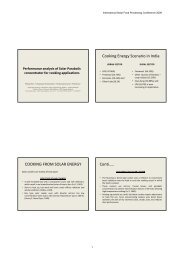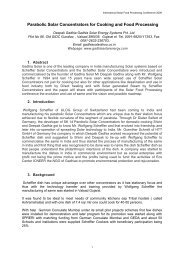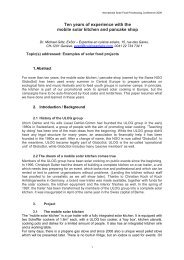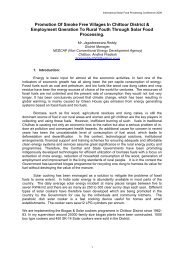Abstracts Oral Presentations - Solar Food Processing Network
Abstracts Oral Presentations - Solar Food Processing Network
Abstracts Oral Presentations - Solar Food Processing Network
Create successful ePaper yourself
Turn your PDF publications into a flip-book with our unique Google optimized e-Paper software.
International <strong>Solar</strong> <strong>Food</strong> <strong>Processing</strong> Conference 2009<br />
Back-up for <strong>Solar</strong> Driers with hygroscopic Calcium Cloride<br />
Wolfgang Scheffler, <strong>Solar</strong>e Bruecke, Graf von Werdenbergstr. 6. D-89344 Aislingen,<br />
wolfgang@solare-bruecke.org, 0049-9075-701338<br />
Heike Hoedt, <strong>Solar</strong>e Bruecke, Graf von Werdenbergstr. 6. D-89344 Aislingen,<br />
HeikeHoedt@solare-bruecke.org, 0049-9075-701338<br />
Topic(s) addressed: <strong>Solar</strong> food processing and back-up systems, how to<br />
ensure sustainable energy supply<br />
1. Introduction<br />
<strong>Solar</strong> driers often need a back-up for periods without sunshine. A simple system is<br />
presented, using liquid and solid CaCl2*(H2O)x as a recyclable absorbent for excess<br />
humidity. The authors used this system successfully to dry plums in a 2m x 1m solar tunnel<br />
drier in Germany under changing weather conditions.<br />
2. Summary<br />
When the sunshine fails during the drying process in a solar tunnel drier, the fruits or<br />
vegetables can get spoiled. In Germany, on several occasions we used food grade<br />
hygroscopic Calcium Cloride salt in combination with an internal fan for closed loop<br />
air circulation to keep the air in the drier dry on rainy or overcast days. That way the<br />
the drying process was continued and spoiling was prevented.<br />
The dry salt is placed on stainless steel trays in the empty section of the tunnel drier together<br />
with an electric fan to ensure a continuous movement of the internal air. Then all openings of<br />
the drier are closed. The solid CaCl2 absorbs the humidity and turns liquid. The liquid is later<br />
recycled by boiling the water off on a 2m² Scheffler reflector.<br />
37



